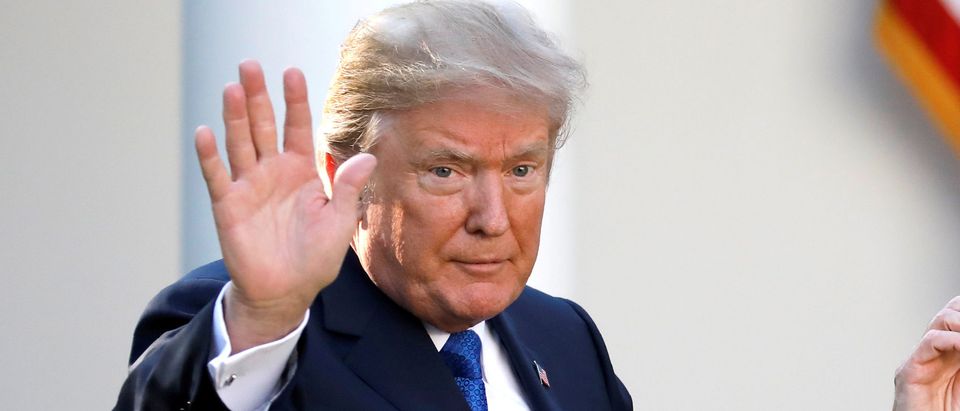President Trump is toying with fire and, by doing so, courting an economic disaster only months before the 2020 presidential election. With interest rates already extremely low by historical standards, the president is jawboning Federal Reserve Chairman Jerome Powell to lower rates further this month to prolong what is now the longest U.S. economic expansion on record. It won’t work; here’s why.
We’ve already had a decade of major economic-policy structural distortions. As the 2008-2009 Great Recession unfolded, the Federal Reserve took appropriate steps to prevent a greater economic collapse: quantitative easing pumped money directly into the economy, and lower interest rates stopped the hemorrhaging.
The Fed increased its balance sheet from roughly $500 billion to $4.5 trillion during this period to prevent the housing and financial markets from collapsing. The Congress and presidents George W. Bush and Barack Obama promptly enacted stimulus packages: a Troubled Asset Recovery Plan and supposedly “shovel-ready” infrastructure investments. In doing so, they averted disaster but presided over significant increases in the national debt. (KOLB: The Federal Reserve Supplies The Obama-Trump Cocaine Economy)
We now face a situation where monetary and fiscal policy are, effectively, tapped out. How much lower can interest rates go? How much more can we expand our $22 trillion national debt? Sustained economic growth based on artificially cheap and borrowed money is wishful thinking.
Already, a quarter of the world’s economy has negative interest rates. Most of the world’s major economies also face significant budget deficits. Europeans are flirting with restarting quantitative easing, and many officials there are urging fiscally conservative and surplus-producing Germany and The Netherlands to join the ranks of the big-time deficit spenders.
When you factor in the relatively low inflation rates experienced since 2008, the interest rates over most of the last decade in the U.S. become zero or even negative.
Do most Americans appreciate what negative interest rates mean? Put simply: you pay your bank to hold your money. Or, the bank effectively subsidizes you to take out a home mortgage. The goal is to stimulate spending rather than saving.
For those parts of the world already experiencing negative interest rates, many banks have absorbed the charges rather than pass them on to small depositors. Now, we’re seeing a recent move to levy these costs on larger individual accounts or on corporate accounts. When Americans figure out what’s happening, negative rates here may well spark a populist revolt.
Our decade of distortion has made real asset price discovery impossible. By keeping its thumb on the low-interest-rate scale for too long, the Fed has harmed savers and prompted investors to seek higher yields wherever they can find them.
This scramble for higher yields has now produced: equity valuations in nosebleed territory, far riskier asset investments, real-estate bubbles in major cities around the world (mostly financial hubs), and a global sovereign bond market with $17 trillion in negative yields. Remember when sovereign debt was considered a relatively safe, straightforward investment?
So, let’s get personal: over many years, a hard-working American saves $100,000. If she invests that money in one of these negative-yielding sovereign bonds, at the bond’s maturity date, she’ll get back less money than she put in. The value of those hours spent on the job has suddenly been reduced immediately at the moment of “investment.” Who would make such an immediate, guaranteed losing investment? Does this situation make any sense?
Well, yes, it does make sense if you’re part of a financial-arbitrage community that understands how to make money under these conditions. Likewise, many companies are using this low-interest-rate environment not to invest in future productive capacity but rather to refinance existing debt, underwrite share buybacks, pursue overpriced mergers and acquisitions, and pay excessive compensation.
When interest rates begin to revert to a more normal upward trajectory, today’s house of cards will quickly collapse.
Economists are only now beginning to examine the long-term structural implications of this decade of distortion. Let’s urge them to expedite their research!
Writing in the Sept. 1, 2019, New York Times, former investment banker William Cohan noted, “the explosion of debt issuance has been driven by central bank policies that have kept interest rates historically low, in effect rewarding entities for issuing more and more debt.”
Today’s cocaine economy is the most important domestic issue facing our country. When will the 2020 presidential candidates address this issue? What are their plans for restoring monetary and fiscal sanity? It’s past time for them to tell us.
Charles Kolb was deputy assistant to the president for domestic policy in the George H.W. Bush White House from 1990-1992. From 1997-2012, he was president of the nonpartisan, business-led think tank, the Committee for Economic Development.
The views and opinions expressed in this commentary are those of the author and do not reflect the official position of The Daily Caller.


